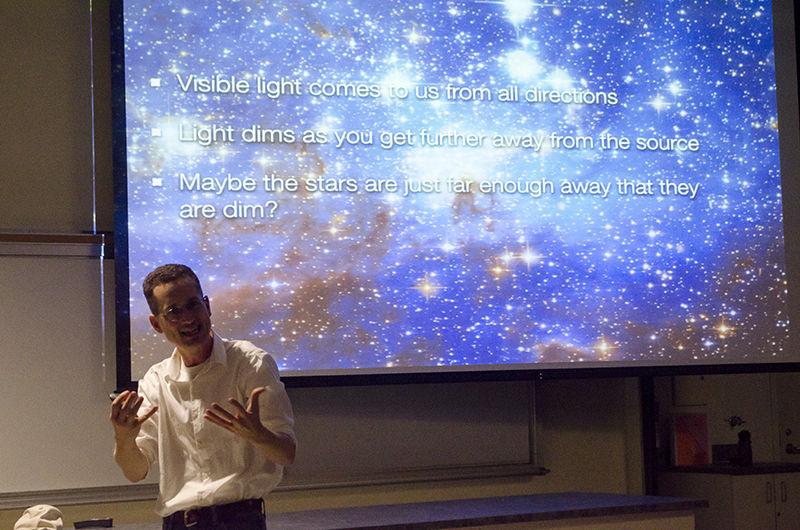Lecture shines light on Astronomy Program
Astronomy Professor, Seth Hillbrand gives a free public lecture on October 7, 2014 on the topic of “Why Is the Night Sky Dark?” In his lecture, Hillbrand discusses various theories and advancements throughout the years that attempt to answer this question.
October 15, 2014
When looking up into the night sky, people tend to experience a multitude of emotions, from wondering if the lights they’re seeing are stars or planets or the occasional satellite, to contemplating where they stand in the scope of our universe.
On Oct. 7, Sacramento State Physics Lecturer Dr. Seth Hillbrand presented a unique question in a free lecture for the public, titled “Why Is The Night Sky Dark?”
“The obvious answer to our question is that the sun went down. But it’s not so simple,” said Hillbrand during the introduction to his lecture. “There’s still light in the sky even when the sun’s gone down, which opens up an incredible amount of deeper questions about cosmology.”
His talk covered each advancement toward the answer in chronological order, starting with Olber’s paradox, named after the 17th century German astronomer, which argues the dark night sky conflicted with the assumption of an infinite and static universe – the common theory during that time.
The paradox led into the more modern advancements that contributed to the over-arching question of Hillbrand’s lecture, from Einstein’s theory of general relativity to Edwin Hubble’s discovery of an infinitely expanding universe.
Hillbrand’s lecture was accompanied with visual guides to help illustrate the advancements toward answering why we see dark in-between the stars, including the monitored cosmic microwave background radiation measured by NASA’s Cosmic Background Explorer, COBE.
“The COBE satellite sees what lies in the darkness between the stars that we can see,” Hillbrand said. “If the satellite stares long enough at one patch of sky, we will see billions and billions of galaxies.”
While a definitive answer to the lecture title has not yet been reached, students who attended the event felt more informed about how the question is being explored.
“I’m not really a science-type person,” said junior communications major Justine Hurt, who saw the event flyer when waiting for a friend in Sequoia Hall. “But this was really interesting and I’d definitely like to go to more.”
In addition to presenting the focal question asked in the talk’s title, Hillbrand also spent a good portion discussing the astronomical advancements being done on campus.
“At Sac State, we’re working towards building telescopes using balloons to take further measurements of microwave radiation,” Hillbrand said. “Our last telescope was launched in December of 2012 from our facility in Antarctica, off a glacier called the Ross Ice Shelf.”
As well as the harsh Antarctica climate, Hillbrand said the students who traveled to the chilly facilities had to deal with a nearby volcano that would erupt occasionally.
“It’s a very rugged environment,” Hillbrand explained.
Students from Sac State worked on various technology implemented in the telescope, such as stabilizing equipment. The balloon used to lift the payload was provided by NASA, and the launch was overseen by Hillbrand and his students.
“I thought that was super cool,” said freshman economics major Kyle Persons about the telescope launches. “I had no idea there were people on campus working with NASA. That’s insane.”
The event culminated in a public observation of several astral bodies using the observation equipment on top of Amador Hall.
Attendees to the observation were given the opportunity to see the moon, Mars, and the stars Vega and Alberio using two different kinds of telescopes.
“I’m really happy to see that the event was pretty packed,” said Glenford Kennedy, a Sac State alumnus from the physics and astronomy department. “It’s really about taking a minute to look into a telescope and observe the things that we can’t see with our normal eyesight.”
Kennedy, who is currently in Sac State’s teaching credentials program, was called in to help assist with the observation.
“When I was an undergraduate, I worked as an assistant for the Astronomy Six Lab,” said Kennedy. “It’s humbling, and I think that it’s really important that we don’t lose sight of the bigger things around us.”
Similar events have been held in the past, but Hillbrand’s talk and observation was the most recent in the past few years, and was used in part to gauge the public response on the event.
Sac State offers a minor in astronomy through the Department of Physics and Astronomy and interested students are encouraged to get into contact with the department for news on future lectures.





























































































































